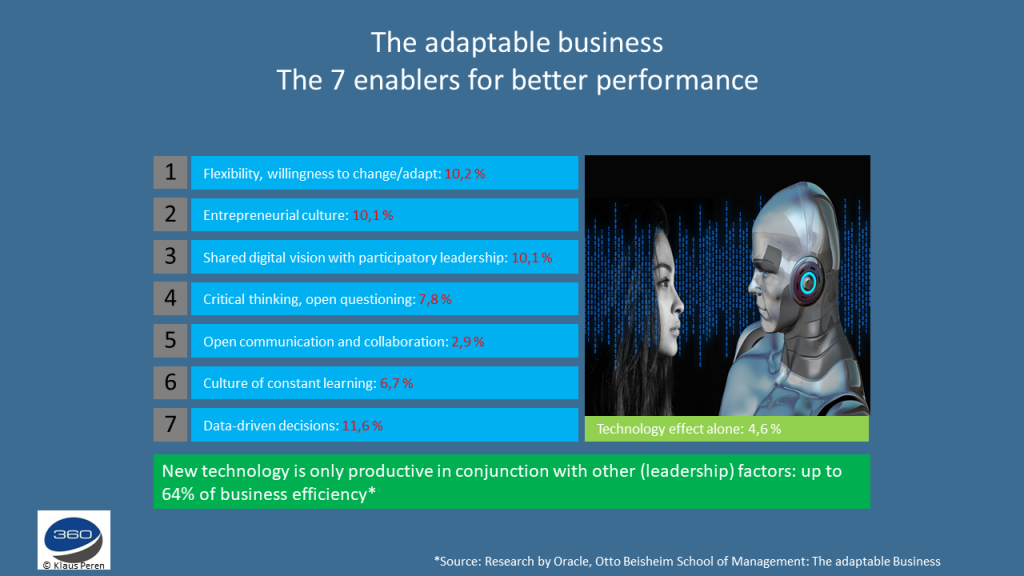The second of my series on success factors of companies deals with the two aspects of a data-based goal and decision-making process and what „customer-oriented organization“ means to me. Both topics have an interface to the first article „Mindset“ in many places, e.g., with the agile principles of customer proximity, self-organizing teams, and collaboration.
Data and Goals
Companies make insufficient use of data for their decision-making. A good proof of this is provided by the global study „The adaptable Business“[1] by Oracle. According to the study, the use and analysis of data is not a standard within the decision-making process for more than half of companies. A lot of potential is wasted. According to the study, a data-driven decision-making process is the biggest lever for improving productivity.

The reasons are insufficient systemic data integration, non-consistent data in subsystems and a lack of know-how to analyse data[2]. Besides there are also the challenges of data protection and the fear of performance and behaviour control.
But there are deeper lying causes: the resistance to change, and here especially in the triggered transparency. When it comes to data that reflects our everyday work, we prefer to work privately and „unobserved“ and perceive transparency as control. Seeing transparency about data not as a threat, but as a support, is the necessary shift in mindset for organizations, managers, and employees. Data shows us where we can get better and learn. If we see data as the basis for pointing out personal and organizational development opportunities, we can resolve these resistances. Embedded in an error culture that sees errors as the start of improvements without blame.
Data is the basis of goals. Goals that are not measurable are of little help because a change cannot be evaluated. Goals help us to focus on the important topics, to continuously improve and become more proactive. A good framework for a goal process are Objective Key Results – OKR ́s. What exactly this is and how to implement it, you can read in the article linked here. And besides, the focus on goals is the basis of an efficient coaching process and thus good leadership.
In this post, I also shared my reserved position on incentivizing individual goals. Incentive means that the agreement of objectives becomes the subject of negotiation and, as a result, the level of ambition is lower than without. Ambition levels are lowered so as not to jeopardize the bonus. If you still want to try it, I recommend piloting or testing the concept in a selected area under realistic conditions (including incentives). The results of team-oriented incentives are much better, so I recommend trying this one. The Royal Society of Arts‘ video about what actually motivates us is always good start.
Customer focused organization
This section is about the structure and process organization, not about organizational development in the broader sense. As part of a leadership concept „ambidexterity“, the focus on customers in the organization means that companies must find their way between hierarchical concepts and network approaches. Division of labour, top-down control on the one hand is opposed to decentralized decision-making competence, with customer-oriented, partly self-steering teams.
There are very exciting approaches to this. For me, the guideline for the concrete design is: The more standardized the work, the required process discipline, the more hierarchical approaches make sense. The higher the development and innovation share and the more complex the tasks, the more likely are decentralized approaches up to self-controlling teams successful. And it is always the case that solutions are judged based on customer expectations and the efficiency of the processes.
Ambidexterity also means that both approaches can occur side by side in companies and a change towards decentralization is a (for me an emerging) trend. But you can also work flexibly in hierarchies if the mindset is based on collaboration and support, employees work in a networked manner and have freedom within their processes.
Because for me mindset is more important than a concrete structure and process organization, organizations do not have to be changed frequently. Also, reorganizations should not be used because conflicts in management are not addressed. A can’t do with B and vice versa. Issues that lie in a shared responsibility are then resolved through adjustments in the organization, rather than asking both to find solutions to the common challenges. For me, such reorganizations are causing symptoms, they do not address the cause of the problem and eat up unnecessary resources.
As always, I highly appreciate your feedback.
[1] https://go.oracle.com/LP=87049?elqCampaignId=232592%5D , S. 18 und the graphs 30 and 31. The study can be obtained via the link.
[2] Charts 10 to 12 from the Oracle study

1 Kommentar on “The DNA of very successful companies – Part 2: Focus”